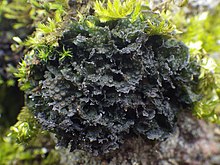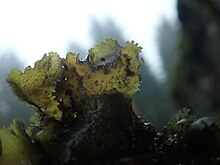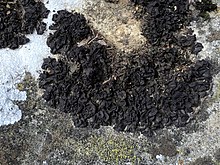| Scytinium | |
|---|---|

| |
| Scytinium gelatinosum | |
| Scientific classification | |
| Domain: | Eukaryota |
| Kingdom: | Fungi |
| Division: | Ascomycota |
| Class: | Lecanoromycetes |
| Order: | Peltigerales |
| Family: | Collemataceae |
| Genus: | Scytinium (Ach.) Gray (1821) |
| Type species | |
| Scytenium palmatum (Huds.) Gray (1821) | |
| Synonyms | |
Scytinium is a genus of lichen-forming fungi in the family Collemataceae. It has 49 species. These lichens are typically found on basic rocks, soil, and trees, occasionally in association with mosses. Despite the morphological and ecological diversity within Scytinium, its species share similar ascospore features, such as shape and septation, as well as a small to medium-sized thallus with at least a partial cortex.
Description
Scytinium encompasses lichen species that exhibit a variety of thallus forms, such as crustose, squamulose, minutely foliose, or minutely shrubby. These lichens have a gelatinous texture, and their colour ranges from dark brown and bluish-grey to olive-green. The lobes of Scytinium can be spreading, elongate, or somewhat cylindrical in shape. The upper and lower cortex, when present, is composed of either cuboid cells or flattened, degraded tissue. The medulla contains loosely interwoven or compact hyphae, along with the photobiont Nostoc–a common genus of cyanobacteria.

Both the upper and lower surfaces of Scytinium lichens can vary from smooth to wrinkled or ridged and typically exhibit a matte appearance. While isidia may or may not be present, soredia are absent in this genus. The photobiont cells are generally arranged in distinct chains. The ascomata are in the form of apothecia with a red-brown disc, which can be sessile, laminal, or marginal. The thalline margin is smooth to granulose, isidiate to lobulate, and often persistent. The true exciple is raised, cup-shaped, and predominantly composed of isodiametric cells, ranging in colour from colourless to reddish-brown. The disc is either concave or flat.
The epithecium is colourless to reddish-brown and does not react with a solution of potassium hydroxide or ammonia. The hymenium is colourless, turning blue when exposed to iodine. The hypothecium is shallow, and its colour varies from colourless to pale yellowish. The hamathecium consists of numerous, conglutinate paraphyses that separate in potassium hydroxide and sometimes have branched apices that are somewhat swollen. The asci contain eight spores and are club-shaped (clavate), with a strongly thickened apex that reacts to potassium hydroxide and iodine, turning blue. Ascospores are primarily ellipsoidal, muriform, and colourless, lacking any distinct surface ornamentation or perispore. Conidiomata, or pycnidia, are infrequent in Scytinium species. No lichen products have been detected in Scytinium species using thin-layer chromatography.
Species
As of December 2024, Species Fungorum (in the Catalogue of Life) accepts 48 species of Scytinium.




- Scytinium apalachense (Tuck.) Otálora, P.M.Jørg. & Wedin (2013)
- Scytinium aquale (Arnold) Otálora, P.M.Jørg. & Wedin (2013)
- Scytinium aragonii (Otálora) Otálora, P.M.Jørg. & Wedin (2013)
- Scytinium biatorinum (Nyl.) Otálora, P.M.Jørg. & Wedin (2013)
- Scytinium bosoense (H.Harada) Otálora, P.M.Jørg. & Wedin (2013)
- Scytinium californicum (Tuck.) Otálora, P.M.Jørg. & Wedin (2013)
- Scytinium callopismum (A.Massal.) Otálora, P.M.Jørg. & Wedin (2013)
- Scytinium cellulosum (P.M.Jørg. & Tønsberg) Otálora, P.M.Jørg. & Wedin (2013)
- Scytinium chibaense (H.Harada) Otálora, P.M.Jørg. & Wedin (2013)
- Scytinium contortum (Sierk) Otálora, P.M.Jørg. & Wedin (2013)
- Scytinium dactylinum (Tuck.) Otálora, P.M.Jørg. & Wedin (2013)
- Scytinium erectum (Sierk) Otálora, P.M.Jørg. & Wedin (2013)
- Scytinium euthallinum (Zahlbr.) Otálora, P.M.Jørg. & Wedin (2013)
- Scytinium ferax (Durieu & Mont.) Otálora, P.M.Jørg. & Wedin (2013)
- Scytinium fragile (Taylor) Otálora, P.M.Jørg. & Wedin (2013)
- Scytinium fragrans (Sm.) Otálora, P.M.Jørg. & Wedin (2013)
- Scytinium gelatinosum (With.) Otálora, P.M.Jørg. & Wedin (2013)
- Scytinium imbricatum (P.M.Jørg.) Otálora, P.M.Jørg. & Wedin (2013)
- Scytinium intermedium (Arnold) Otálora, P.M.Jørg. & Wedin (2013)
- Scytinium juniperinum (Tuck.) Otálora, P.M.Jørg. & Wedin (2013)
- Scytinium kauaiense (H. Magn.) Otálora, P.M.Jørg. & Wedin (2013)
- Scytinium leptogioides (Anzi) Otálora, P.M.Jørg. & Wedin (2013)
- Scytinium lichenoides (L.) Otálora, P.M.Jørg. & Wedin (2013)
- Scytinium magnussonii (Degel. & P.M.Jørg.) Otálora, P.M.Jørg. & Wedin (2013)
- Scytinium massiliense (Nyl.) Otálora, P.M.Jørg. & Wedin (2013)
- Scytinium nanum (Herre) D.F.Stone & McCune (2022)
- Scytinium palmatum (Huds.) Gray (1821)
- Scytinium palustre (P.M.Jørg.) Otálora, P.M.Jørg. & Wedin (2013)
- Scytinium parculum (Nyl.) Otálora, P.M.Jørg. & Wedin (2013)
- Scytinium parvum (Degel.) Otálora, P.M.Jørg. & Wedin (2013)
- Scytinium platynum (Tuck.) Otálora, P.M.Jørg. & Wedin (2013)
- Scytinium plicatile (Ach.) Otálora, P.M.Jørg. & Wedin (2013)
- Scytinium polycarpum (P.M.Jørg. & Goward) Otálora, P.M.Jørg. & Wedin (2013)
- Scytinium pulvinatum (Hoffm.) P.M.Jørg. & Wedin (2014)
- Scytinium quadrifidum (D.F.Stone & McCune) A. Košuth. & Wedin (2019)
- Scytinium rivale (Tuck.) Otálora, P.M.Jørg. & Wedin (2013)
- Scytinium rogersii (Verdon) Otálora, P.M.Jørg. & Wedin (2013)
- Scytinium schraderi (Ach.) Otálora, P.M.Jørg. & Wedin (2013)
- Scytinium singulare Carlberg & P.M.Jørg. (2016)
- Scytinium siskiyouense (D.F.Stone & Ruchty) Otálora, P.M.Jørg. & Wedin (2013)
- Scytinium subaridum (P.M.Jørg. & Goward) Otálora, P.M.Jørg. & Wedin (2013)
- Scytinium subfragrans (Degel.) Otálora, P.M.Jørg. & Wedin (2013)
- Scytinium subtile (Schrad.) Otálora, P.M.Jørg. & Wedin (2013)
- Scytinium subtorulosum (Nyl. ex Stizenb.) Otálora, P.M.Jørg. & Wedin (2013)
- Scytinium tacomae (P.M.Jørg. & Tønsberg) McCune (2014)
- Scytinium tenuilobum P.M.McCarthy (2017) – Australia
- Scytinium tenuissimum (Hoffm.) Otálora, P.M.Jørg. & Wedin (2013)
- Scytinium tetrasporum (Th.Fr.) Otálora, P.M.Jørg. & Wedin (2013)
- Scytinium turgidum (Ach.) Otálora, P.M.Jørg. & Wedin (2013)
References
- "Synonymy: Scytinium (Ach.) Gray [as 'Scytenium'], Nat. Arr. Brit. Pl. (London) 1: 398 (1821)". Species Fungorum. Retrieved 24 April 2021.
- ^ "Scytinium". Catalogue of Life. Species 2000: Leiden, the Netherlands. Retrieved 14 December 2024.
- Wijayawardene, N.N.; Hyde, K.D.; Dai, D.Q.; Sánchez-García, M.; Goto, B.T.; Saxena, R.K.; et al. (2022). "Outline of Fungi and fungus-like taxa – 2021". Mycosphere. 13 (1): 53–453 . doi:10.5943/mycosphere/13/1/2. hdl:10481/76378. S2CID 249054641.
- ^ Cannon, Paul; Otálora, Mónica A.G.; Košuthová, Alica; Wedin, Mats; Aptroot, André; Coppins, Brian; Simkin, Janet (2020). "Peltigerales: Collemataceae, including the genera Blennothallia, Callome, Collema, Enchylium, Epiphloea, Lathagrium, Leptogium, Pseudoleptogium, Rostania and Scytinium". Revisions of British and Irish Lichens. 2: 1–38 . doi:10.34885/174.

- McCune, Bruce; Stone, Daphne F. (2022). "Eight new combinations of North American macrolichens". Evansia. 39 (3): 123–128. doi:10.1639/0747-9859-39.3.123.
- McCarthy, P.M. (2017). "A new species of Scytinium (Ach.) Gray (lichenized Ascomycota, Collemataceae) from the Australian Capital Territory". Australasian Lichenology. 80: 53–57.
| Taxon identifiers | |
|---|---|
| Scytinium | |